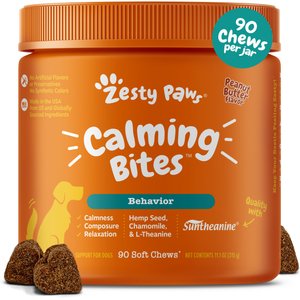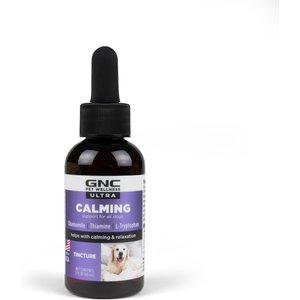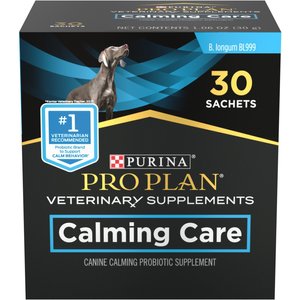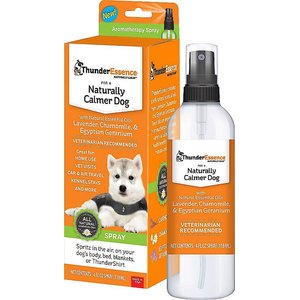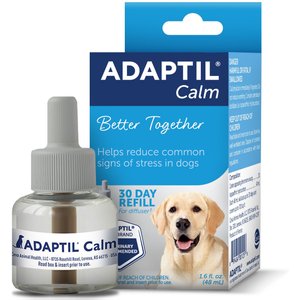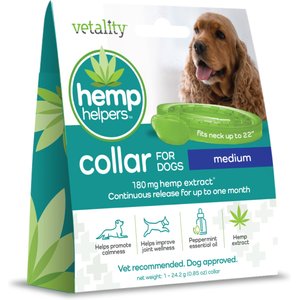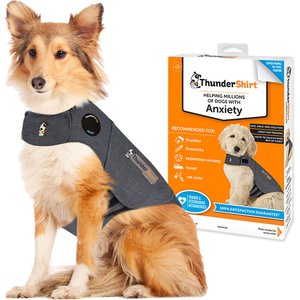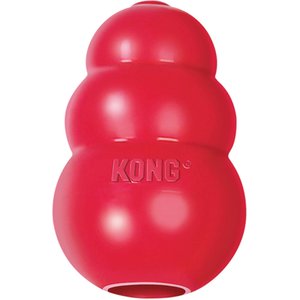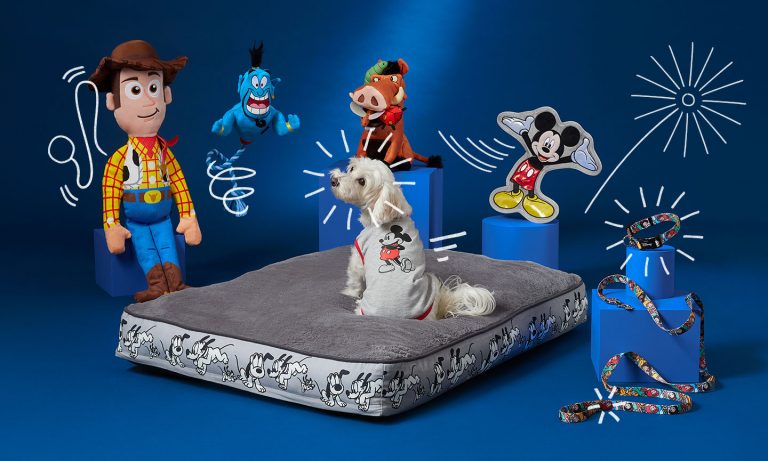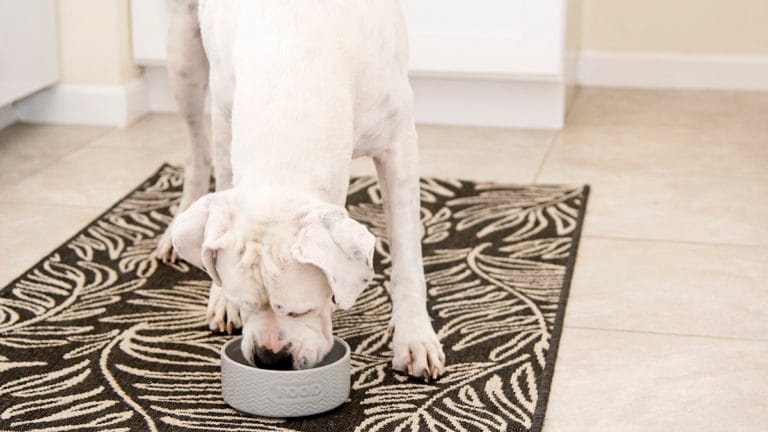When your pup’s dealing with stress or occasional anxiety, it’s only natural to want to do whatever you can to help them feel at ease. Whether you have a dog who sometimes struggles with separation anxiety or who gets upset about stressful events like thunderstorms, fireworks or trips in the car, the best calming aids for dogs can help them stay calm, cool and collected. To help you choose the right one for your anxious fur baby, we’ve rounded up the best dog calming aids based on Chewy customer sales, ratings and reviews.
- 1
- 2
-
3
Best Liquid Dog Calming SupplementGNC Pets ULTRA Calming Tincture Dog Supplement, 60-ml bottle $20 on Chewy
-
4
Best Powder Dog Calming SupplementPurina Pro Plan® Calming Care Powder Supplement for Dogs, 30 count $34 on Chewy
- 5
How To Find the Best Dog Calming Aid
There are a variety of different types of dog calming aids on the market (see more on the types below). Andrea Cermele, DVM, a veterinarian at Best Friends Animal Society, says to consider the following before buying:
- The source of stress or anxiety: Understanding what causes your dog’s anxiety can help determine which type of calming aid is best. Dr. Cermele says anxiety in dogs can stem from various factors, such as separation from their pet parent, changes in their environment, loud noises or even their health. A short-term solution like a dog calming chew may work well for a visit to the vet, while a longer-term solution like a compression vest or plug-in diffuser may be best for separation anxiety or ongoing anxiousness.
- Your dog’s preferences: All dogs are different, so consider what your dog may be more drawn to before buying a calming aid. For example, some may not like to wear items, so a calming collar or anti-anxiety vest wouldn’t work well for them. Others may really enjoy treats, which would make calming treats a good option to try.
- Whether it’s suitable for dogs: Even though DIY remedies (including essential oils) are well-meaning, not all of them are suitable for dogs. Always select a calming aid that is specifically designed for dogs and highly rated and well reviewed. When opting for a calming supplement, look for the National Animal Supplement Council (NASC) Quality Seal on the package, which indicates that a company has undergone a third-party audit and meets certain quality-control criteria. Be sure to follow all dosage instructions, too.
- Your vet’s input: Always consult your veterinarian before buying or using any dog calming aids. They can help provide guidance on what to buy, and can also help determine the source of your pet’s stress.
10 Best Dog Calming Aids
Following are the calming products other pet parents just like you use and recommend. As always, remember to consult your veterinarian before trying any calming aid for dogs. They can help you rule out any medical causes for stress and anxiety before you pursue behavioral supplements such as these.
Best Overall Dog Calming Aid
-
Best ever calming chews for a hyper dog
We really love the way this calmed down our 8-month-old lab that just jumps all over the place and flies across the coffee table like she has wings
-
Easing Fear of Thunder
Drake my dog has an extreme fear of thunder due to his abandonment as a puppy at an abandoned duck club rescued and adopted
-
THESE REALLY WORK!!!
I’ve been using these with my dogs for the last 4 years! I first tried this brand & product when we got our Golden Retriever puppy. She’s such a good girl, but she showed signs of anxiety. I didn’t want to put her on medication, so I went with this because of the 100% all natural ingredients! They work so well, I saw a night & day difference from day one! I started out giving her the maximum daily dose for her weight daily. After about a month or so, I dropped to twice a day. Now she only gets one at bedtime. Moose is 110 pounds & I would do a commercial for FREE for this product! My vet was floored at the difference in her...
Best Dog Calming Chew
-
Calmed this puppy down
Fostered a puppy who had moments of nervousness in preparation to meet his new family I started these a few days before meeting them to see how he’d do. Chill without being totally out of it, if you know what I mean
-
How fast they work
Peanut is my pug and due to his short nose he gets in trouble when he barks alot and end up short of breath.
-
Definitely calming!
Our reactive senior dog responds well to these - after dinner each day she just wants to be left alone to rest. This helps her to be quiet and calm and she enjoys it!
Best Liquid Dog Calming Supplement
-
Nervous in storms
I have a 20 lbs dog and only gave her 1/4 of the dose it called for. In 30 minutes she was chilled out and the storms didn’t bother her.
-
Excellent Product
This medication worked really good for my 3 1/2 female Chihuahua. She is terribly afraid of thunderstorms and can sense them before they arrive at our area. I give her this and it calms her down without over sedating. I strongly recommend this product.
-
Calming meds
This worked really well to calm our 60lb fur baby while visiting family at Christmas. They have an older dog and ours is just 1 yr old. Still springy like a puppy. Very good product.
Best Powder Dog Calming Supplement
-
Relieves anxiety
Easy to use, my dog will eat it in her food, and within about 20 minutes she is calmer. I only give it when I know I will be gone several hours since she has separation anxiety.
-
It works!
Have tried several calming products before for my mini schnauzer that didn’t work or had opposite reaction, but this really works!! He is used to getting it on his food once a day with a little warm water to make a gravy and he loves it! He finally sleeps a full night and I finally get to rest too! No more separation anxiety!
-
Improvement for senior dog
Vet recommended we try this for our 13 year old dog who struggles with Canine Cognitive Dysfunction. This is one of the tools we tried and after 6 weeks I realized he was doing a bit better overall. He still gets other medications but this seems to have helped turn down some of the anxiety and generally improved his mood so we're keeping him on it!
Best Dog Calming Spray
-
Help-At last!
My dog gets very nervous during thunderstorms and fireworks. I bought a Thunder shirt and that helped. I supplemented it with the Thunder Essence and that calmed him. It made him feel better; that makes me feel better.
-
A WONDERFUL SCENT FOR BOTH DOGS AND THEIR OWNERS
I purchase multiple bottles of this and use it instead of room air freshener throughout my home. I also spray it on all of my dog beds, but also my bed, and the upholstered furniture too. This is totally different than the other type of Calming spray (made by the same company) that you're supposed to spray on the black dot on the front of the Thundershirts. This is all natural calming scents that are very enjoyable. The two products smell completely different, FYI, and the other spray bottle (smaller bottle) can only be used in certain areas and in limited amounts. If you read the ingredients in this spray, I think you'll also...
-
Great spray
My dog was a basket case during storms. This spray on her blanket calmed her down immediately. I could not believe it.
Best Diffuser for Calming Dogs
-
Worked great
When we rescued this dog he had bad anxiety. I used this for 30 days and I truly believe it helped calm him to his new environment.
-
calming for my dog
this has definitely worked on both my dogs. if it was not in use my dogs were more stressed. highly recommended
-
It works!
I can tell when this plug in is nearing the end both my dog and cat start acting up more than normal
Best Dog Calming Collar
-
Happy Dog
After having worn an adaptil collar for years, this collar was a great surprise in how well it soothed my reactive dog.
-
Very helpful
My elderly rottweiler has shown signs if anxiety throughout her older years but this necklace has helped quite a bit. Especially when we have company.
-
Hemp helper calm collar
My dog has been so much calmer since we started using this collar. I love the scent. it is really easy to size and it stays on.
Best Anti-Anxiety Apparel for Dogs
-
Scared dog turned brave
My rescue pup was so so scared of thunderstorms and fireworks. She would shake and seek out my comfort. A couple of times putting this vest on her before or during these events has helped her gain so much more confidence.
-
It helps
This shirt really seems to relax and calm my dog. He runs over tome when it’s time to put it on.
-
It worked
My Blue Merle Border Collie is extremely hyper. put the thunder shirt on her and it had a calming effect on her plus she rode better in the car.
Best Toy for Calming Dogs
-
Great for Chewing
We use this for a chew toy. My German Shepherds love to chew and fetch this Kong. They have not yet destroyed any part of this though they have smaller ones. I do not put food in it.
-
More durable than most
This Kong is more durable than most treat filler toys and has managed to survive a couple of weeks with my super chewing GSD.
-
Perfect for enrichment
My dog loves this one, I have many of them and make sure to put them on the freezer for a quick enrichment snack!
Best Dog Calming Bed
-
My boys are obsessed
My cats absolutely love this bed! It’s perfect for them to snuggle up together or stretch out on their own (for reference I bought size medium, and my cats are both very long and large). It’s the perfect size, shape, and texture for them. The cushioning in the center is a little thick, but not so thick they won’t use it. So far the faux fur cover holds up after cold water wash and air dry, no matting, pulling, or texture problems. It’s super soft and cozy. Seems like it should last awhile. Love that the cover is removable. Highly recommend!!
-
Soft
Our 25lb dog loves his new bed. It’s roomy for him, but better than ones he’s had that are too small.
-
FITS LIKE A GLOVE
Willow tried out her new donut, circled around and made herself comfortable. She's white and disappears into the white bed except for her big black eyes. Even her larger sister tried it and opted to lie in it with her head and rear extended. What a great find this bed is. I should also say it's very well made.
How We Chose These Products
All the products we’re featuring in our list of dog calming aids are best-sellers at Chewy that are also top-rated, having a 4-star rating or higher. You can rest assured that customers—dog parents just like you—have used these products and love them. We know how tough it can be to navigate the retail space, so we wanted to take that burden off your shoulders so you and your pup can feel better pronto.
Types of Dog Calming Aids
Just as there are many different types of stressful scenarios, there are many different types of calming aids for dogs. Here are some of the most common options.
Calming Supplements
Calming supplements, delivered via dog chews, powder or liquid drops, are a useful way to manage your dog’s occasional anxiety. The chews can be given on their own, while the liquid drops and powder supplements are usually mixed in with the pet’s food. You get the benefit of leveraging a familiar object (that they enjoy) to administer the supplement, and they enjoy the snack.
“These products often contain ingredients such as L-theanine, L-tryptophan, valerian root, chamomile and melatonin,” says Dr. Cermele. “Many dog owners find these effective for reducing stress related to situations like thunderstorms, travel or visits to the vet office.”
Other common ingredients used in these calming chews include ginger and thiamine. What’s not to love about a savory chicken-flavored, pork-flavored or bacon-flavored treat that has wellness benefits, too?
Calming Sprays
Dog calming sprays help reduce reactions to stressful situations either through “dog-appeasing pheromones” (DAP) or natural ingredients known for their calming benefits, such as lavender and chamomile. They work by mimicking natural calming signals that help your pup feel more at ease, making them ideal for short-term stressful events such as thunderstorms, travel or fireworks.
They’re typically sprayed on your dog’s environment, bedding or directly on the fur (if deemed safe). (Note: If you have different types of pets in the home, like a cat, make sure the spray is fully dry before letting your pets interact. Products meant for dogs could be toxic to cats.)
Plug-in Diffusers
Wall diffusers plug directly into an electrical outlet and disperse a calming pheromone into the air to help soothe your pup, Dr. Cermele explains.
They’re similar to sprays, only they emit the scent non-stop versus for short periods of time. That makes them suitable for situations when your dog experiences longer durations of stress—like when you’re away from the house and they have separation anxiety—or in cases where your pup is often on edge.
Calming Collars
Calming collars are placed around your dog’s neck and emit a calming smell via pheromones or herbal ingredients. “The most popular type of calming collar uses synthetic versions of the pheromone that mother dogs produce to soothe their puppies,” Dr. Cermele says. “Studies and subjective evidence suggest that pheromone-based collars can be effective in reducing anxiety in many dogs, particularly for ongoing stressors like periods of separation, changes in the home environment or loud noises like fireworks.”
She adds that herbal-based collars, which use ingredients such as lavender and chamomile, may also have a soothing effect, though their effectiveness can vary more widely among individual dogs.
Generally speaking, calming collars are non-invasive and convenient, making them a practical option for dog parents who may find it challenging to administer supplements or other calming aids regularly.
Anti-Anxiety Apparel
Certain garments are designed to have a calming effect on dogs, including anti-anxiety vests and calming caps. They provide gentle compression similar to swaddling. The light, constant pressure helps calm your dog’s nervous system. Vests compress your dog’s body, while caps create pressure around their head. (Note: For caps, you’ll want to make sure they aren’t so tight as to cause choking.) Since they’re placed over your dog’s ears, they can also help reduce stressful loud noises.
“Many dogs find this pressure comforting, and it can help reduce anxiety during stressful situations such as travel, vet visits or thunderstorms,” Dr. Cermele says. They can also work well for grooming sessions (especially caps to shield pets from the new noises) and other overwhelming environments.
Toys
Stress-relieving dog toys are specifically designed to provide your pup with mental stimulation, comfort and, yeah, a bit of distraction from whatever’s making them feel anxious. These toys often incorporate features such as calming scents, treat-dispensing mechanisms and soft, chewable materials.
Some examples include lick mats, interactive puzzles, and frozen toys or objects that they can chew for long periods of time. These are great for when your pup is left alone or going through a stressful event at home, like a thunderstorm or when you have visitors.
How To Calm Dogs
Stressed or anxious dogs exhibit both clear and subtle signs. Dr. Cermele says that obvious signs include:
- Excessive barking or whining
- Cowering
- Trembling
- Growling
- Snapping
- Biting
- Panting (not related to exercise or heat)
- Pacing
- Digging
- Appetite changes
- Destructive behaviors like chewing or getting into items they shouldn’t
“Less obvious signs of stress include yawning when not tired and excessive lip licking,” Dr. Cermele says. “Dogs may also show avoidance behaviors, such as turning away, hiding or trying to escape from a situation. Excessive drooling, dilated pupils or seeing more of the whites of the eyes—known as whale eye—can also indicate stress.”
If you notice any of these symptoms in your dog, it’s important to get to the bottom of the issue. Follow these expert tips from Dr. Cermele for helping to calm stressed dogs.
Step 1: Identify the Stress Trigger
Observe your dog’s behavior and try to pinpoint what triggers their anxiety. Common causes of stress in dogs include loud noises, separation from their pet parents, new environments or experiences, health issues and a history of trauma. All these sources will require unique approaches to calming your dog’s anxiety.
Step 2: Create a Safe Environment
One of the best things you can do to help ease your dog’s stress levels is to provide them with a safe space with accessibility. Set up a quiet, comfortable area where your dog can retreat, with their bed, toys and blankets. Do what you can to minimize exposure to triggers like loud noises or unfamiliar environments or experiences.
Step 3: Try Calming Aids
Along with a safe environment, it’s often helpful to soothe your pup with calming aids, including the options we’ve included above. You’ll want to choose the best type of calming aid for your dog’s source of anxiety and their personal preferences. Always use these items according to instructions and consult with your veterinarian for advice.
Step 4: Engage in Calming Activities
Dogs require both mental and physical stimulation to help reduce their overall anxiety levels and boost their well-being. Make sure to engage them in regular physical exercise via walks, indoor playtime, or outdoor parks and activities. Mental stimulation can come from interactive games, like puzzles and tug-of-war. Training is another great way to mentally engage your pup.
Step 5: Maintain Consistency
As best as you can, try to maintain consistent schedules for feeding, walking and playtime. Sticking to a schedule helps your dog know what to expect each day. During situations that are out of the norm or stress-inducing, provide your dog with calming aids and activities, adjusting as needed to suit their needs.
Talk to Your Veterinarian
While calming products for dogs are helpful, it’s important to remember that every pup is unique and all situations require individualized treatment. “Consulting with a veterinarian before starting any new calming aid is always a good idea, as they can provide guidance tailored to your dog’s specific needs and ensure there are no underlying health issues contributing to their anxiety,” Dr. Cermele says.
She also recommends veterinary intervention for a stressed or anxious dog anytime signs of stress don’t resolve or worsen with simple behavioral interventions, and in cases where your dog’s anxiety is causing significant behavioral changes, such as aggressive tendencies, excessive barking, destructive behavior or withdrawal.
Dog Calming FAQs
Q: What is the best thing to calm a dog?
A: The best way to calm a dog is to determine the source of their stress or anxiety and do what you can to minimize the stressor. Creating a calm and safe environment can help, as can using a dog calming aid such as a calming collar, vest or treat.
Q: Do calming aids work for dogs?
A: Yes, dog-specific calming aids can work well for dogs. There’s research and anecdotal evidence that supports the use of pheromone-based dog calming products, chew toys, calming treats and beyond. The type of aid you use will depend on the cause of stress and your dog’s preferences.
Q: Are there any side effects associated with dog calming aids?
A: Dog calming aids are generally considered safe, but there are potential side effects to consider. These include digestive issues, sedation, skin irritation from collars, respiratory problems with sprays, discomfort from vests, potential toxicity from aromatherapy, overconsumption with treats and behavioral dependency. Consult a vet before use and monitor for adverse reactions.
Q: Can I give my dog a calming aid before a vet visit?
A: Some pet parents find it very helpful to provide their dog with a calming aid before going to the vet or groomer, which are understandably stressful situations. This can range from giving them a calming supplement (like a chew), giving them a calming toy, or putting them in a calming vest or cap.
Life can be stressful, but that doesn’t mean your dog has to be stressed-out. Give them a new sense of ease, whether they’re faced with loud noises or car rides, with the best calming aids for dogs. Looking for other ways to reduce your dog’s stress? Check out our guide on how to calm dogs with anxiety.
Expert input provided by Andrea Cermele, DVM, a veterinarian at Best Friends Animal Society, a leading national animal welfare organization.
This content was medically reviewed by Chewy vets.
More on how you and your dog can stress less:
Share:


